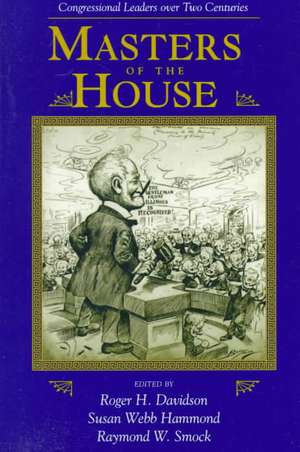Masters Of The House: Congressional Leadership Over Two Centuries
Autor Roger H. Davidson, Susan Hammond, Raymond Smocken Limba Engleză Paperback – 17 apr 1998
| Toate formatele și edițiile | Preț | Express |
|---|---|---|
| Paperback (1) | 427.16 lei 6-8 săpt. | |
| Taylor & Francis – 17 apr 1998 | 427.16 lei 6-8 săpt. | |
| Hardback (1) | 669.94 lei 6-8 săpt. | |
| Taylor & Francis – 27 aug 2019 | 669.94 lei 6-8 săpt. |
Preț: 427.16 lei
Preț vechi: 502.54 lei
-15% Nou
Puncte Express: 641
Preț estimativ în valută:
81.76€ • 84.26$ • 69.02£
81.76€ • 84.26$ • 69.02£
Carte tipărită la comandă
Livrare economică 03-17 martie
Preluare comenzi: 021 569.72.76
Specificații
ISBN-13: 9780813368955
ISBN-10: 0813368952
Pagini: 358
Dimensiuni: 152 x 229 x 20 mm
Greutate: 0.45 kg
Ediția:New.
Editura: Taylor & Francis
Colecția Routledge
Locul publicării:Oxford, United Kingdom
ISBN-10: 0813368952
Pagini: 358
Dimensiuni: 152 x 229 x 20 mm
Greutate: 0.45 kg
Ediția:New.
Editura: Taylor & Francis
Colecția Routledge
Locul publicării:Oxford, United Kingdom
Cuprins
Foreword -- Credits -- Introduction: Rediscovering the “Masters of the House” -- The Start of Something New: Clay, Stevenson, Polk, and the Development of the Speakership, 1789-1869 -- Thomas Brackett Reed and the Rise of Party Government -- Uncle Joe Cannon: The Brakeman of the House of Representatives, 1903-1911 -- Oscar W. Underwood: The First Modern House Leader, 1911-1915 -- Nicholas Longworth: The Genial Czar -- John Nance Garner -- The Speaker and the Presidents: Sam Rayburn, the White House, and the Legislative Process, 1941-1961 -- Hale Boggs: The Southerner as National Democrat -- Gerald R. Ford: Minority Leader of the House of Representatives, 1965-1973 -- Tip O’Neill and Contemporary House Leadership -- Epilogue: Leaders Talk About House Leadership
Notă biografică
Roger H. Davidson, Raymond Smock
Descriere
This book identifies enduring patterns of House leadership, explaining the effects of such factors as party strength, White House-congressional relations, leaders' formal prerogatives, members' expectations, public attitudes, shifts in the policy agenda, and leaders' personal attributes and style.
















